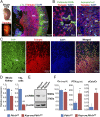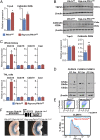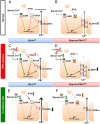Parathyroid hormone controls paracellular Ca2+ transport in the thick ascending limb by regulating the tight-junction protein Claudin14
- PMID: 28373577
- PMCID: PMC5402431
- DOI: 10.1073/pnas.1616733114
Parathyroid hormone controls paracellular Ca2+ transport in the thick ascending limb by regulating the tight-junction protein Claudin14
Abstract
Renal Ca2+ reabsorption is essential for maintaining systemic Ca2+ homeostasis and is tightly regulated through the parathyroid hormone (PTH)/PTHrP receptor (PTH1R) signaling pathway. We investigated the role of PTH1R in the kidney by generating a mouse model with targeted deletion of PTH1R in the thick ascending limb of Henle (TAL) and in distal convoluted tubules (DCTs): Ksp-cre;Pth1rfl/fl Mutant mice exhibited hypercalciuria and had lower serum calcium and markedly increased serum PTH levels. Unexpectedly, proteins involved in transcellular Ca2+ reabsorption in DCTs were not decreased. However, claudin14 (Cldn14), an inhibitory factor of the paracellular Ca2+ transport in the TAL, was significantly increased. Analyses by flow cytometry as well as the use of Cldn14-lacZ knock-in reporter mice confirmed increased Cldn14 expression and promoter activity in the TAL of Ksp-cre;Pth1rfl/fl mice. Moreover, PTH treatment of HEK293 cells stably transfected with CLDN14-GFP, together with PTH1R, induced cytosolic translocation of CLDN14 from the tight junction. Furthermore, mice with high serum PTH levels, regardless of high or low serum calcium, demonstrated that PTH/PTH1R signaling exerts a suppressive effect on Cldn14. We therefore conclude that PTH1R signaling directly and indirectly regulates the paracellular Ca2+ transport pathway by modulating Cldn14 expression in the TAL. Finally, systemic deletion of Cldn14 completely rescued the hypercalciuric and lower serum calcium phenotype in Ksp-cre;Pth1rfl/fl mice, emphasizing the importance of PTH in inhibiting Cldn14. Consequently, suppressing CLDN14 could provide a potential treatment to correct urinary Ca2+ loss, particularly in patients with hypoparathyroidism.
Keywords: CLDN14; PTH1R; hypercalciuria; mouse kidney; paracellular.
Conflict of interest statement
The authors declare no conflict of interest.
Figures











Similar articles
-
PTH/PTHrP Receptor Signaling Restricts Arterial Fibrosis in Diabetic LDLR-/- Mice by Inhibiting Myocardin-Related Transcription Factor Relays.Circ Res. 2020 May 8;126(10):1363-1378. doi: 10.1161/CIRCRESAHA.119.316141. Epub 2020 Mar 11. Circ Res. 2020. PMID: 32160132 Free PMC article.
-
Disruption of β-catenin binding to parathyroid hormone (PTH) receptor inhibits PTH-stimulated ERK1/2 activation.Biochem Biophys Res Commun. 2015 Aug 14;464(1):27-32. doi: 10.1016/j.bbrc.2015.05.082. Epub 2015 Jun 3. Biochem Biophys Res Commun. 2015. PMID: 26047699 Free PMC article.
-
Renal claudin-14 expression is not required for regulating Mg2+ balance in mice.Am J Physiol Renal Physiol. 2021 May 1;320(5):F897-F907. doi: 10.1152/ajprenal.00590.2020. Epub 2021 Apr 5. Am J Physiol Renal Physiol. 2021. PMID: 33818126
-
Role of claudins in renal calcium handling.Nefrologia. 2015;35(4):347-52. doi: 10.1016/j.nefro.2015.06.011. Epub 2015 Jul 22. Nefrologia. 2015. PMID: 26306950 Review. English, Spanish.
-
Lecture: New light on the role of claudins in the kidney.Organogenesis. 2012 Jan-Mar;8(1):1-9. doi: 10.4161/org.19808. Epub 2012 Jan 1. Organogenesis. 2012. PMID: 22504740 Free PMC article. Review.
Cited by
-
The role of calcium-sensing receptor signaling in regulating transepithelial calcium transport.Exp Biol Med (Maywood). 2021 Nov;246(22):2407-2419. doi: 10.1177/15353702211010415. Epub 2021 Apr 29. Exp Biol Med (Maywood). 2021. PMID: 33926258 Free PMC article. Review.
-
The importance of kidney calcium handling in the homeostasis of extracellular fluid calcium.Pflugers Arch. 2022 Aug;474(8):885-900. doi: 10.1007/s00424-022-02725-4. Epub 2022 Jul 16. Pflugers Arch. 2022. PMID: 35842482 Review.
-
The role of claudins in homeostasis.Nat Rev Nephrol. 2023 Sep;19(9):587-603. doi: 10.1038/s41581-023-00731-y. Epub 2023 Jun 21. Nat Rev Nephrol. 2023. PMID: 37344620 Review.
-
Disorders of Calcium Metabolism: Hypocalcemia and Hypercalcemia.Cureus. 2021 Jan 1;13(1):e12420. doi: 10.7759/cureus.12420. Cureus. 2021. PMID: 33542868 Free PMC article. Review.
-
Lysine-specific demethylase 1 as a corepressor of mineralocorticoid receptor.Hypertens Res. 2022 Apr;45(4):641-649. doi: 10.1038/s41440-022-00859-7. Epub 2022 Feb 17. Hypertens Res. 2022. PMID: 35177789
References
-
- Peacock M. Calcium metabolism in health and disease. Clin J Am Soc Nephrol. 2010;5:S23–S30. - PubMed
-
- Bihl G, Meyers A. Recurrent renal stone disease-advances in pathogenesis and clinical management. Lancet. 2001;358:651–656. - PubMed
-
- Painter SE, Kleerekoper M, Camacho PM. Secondary osteoporosis: A review of the recent evidence. Endocr Pract. 2006;12:436–445. - PubMed
-
- Hudec SM, Camacho PM. Secondary causes of osteoporosis. Endocr Pract. 2013;19:120–128. - PubMed
Publication types
MeSH terms
Substances
Grants and funding
LinkOut - more resources
Full Text Sources
Other Literature Sources
Molecular Biology Databases
Research Materials
Miscellaneous

